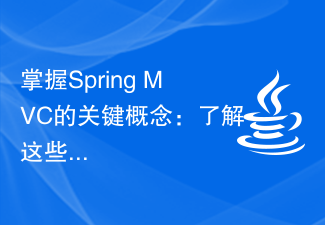HTML 5.1Overview
The release of the HTML5 standard two years ago was a big event for the web development community . Not only because it contains an impressive series of new features, but also because it is the first major version update to HTML since the HTML 4.01 standard was released in 1999. You can still see some websites boasting that they use the "modern" HTML5 standard.

Fortunately we don’t have to wait that long for the next update to the HTML standard. In October 2015, W3C began working on the HTML5.1 draft, with the goal of fixing some of the remaining problems of HTML5. After multiple iterations, the draft reached the "Candidate Recommendation" stage in June 2016, the "Proposed Recommendation" stage in September 2016, and finally the W3C recommendation was released in November 2016. Those paying attention to the new standard may have noticed that it has been a winding road. Many HTML5.1 features that were initially proposed were abandoned due to poor design or lack of browser vendor support.
Although HTML5.1 is still in development, the W3C has begun working on the HTML5.2 draft, which is expected to be released in late 2017. This article is an overview of some interesting new features and improvements in HTML5.1. Browser support for these features is still lacking, but at least we'll show you a few browsers that support these features to test each example against.
Context menu uses menu and menuitems elements
The HTML5.1 draft introduces two different menu elements: context and toolbar. The former is used to extend the local context menu, usually activated by right-clicking the mouse on the page; the latter is used to define a common menu component. During the development process, the toolbar was abandoned, but the context menu survived.
You can use the
The above is the detailed content of What are the new features in HTML5.1?. For more information, please follow other related articles on the PHP Chinese website!
 win7家庭版与win7旗舰版的区别介绍Jul 12, 2023 pm 08:41 PM
win7家庭版与win7旗舰版的区别介绍Jul 12, 2023 pm 08:41 PM大家都知道win7系统有很多种版本,比如win7旗舰版、win7专业版、win7家庭版等,有不少用户在家庭版和旗舰版之间纠结,不知道选择哪个版本比较好,所以今天小编来跟大家说说win7家庭餐与win7旗舰版的区别介绍,大家一起来看看吧。1、体验不同家庭普通版使您的日常操作变得更快、更简单,可以更快、更方便地访问使用最频繁的程序和文档。家庭高级版让您享有最佳的娱乐体验,可以轻松地欣赏和共享您喜爱的电视节目、照片、视频和音乐。旗舰版集各版本功能之大全,具备Windows7家庭高级版的所有娱乐功能和专
 掌握Spring MVC的关键概念:了解这些重要特性Dec 29, 2023 am 09:14 AM
掌握Spring MVC的关键概念:了解这些重要特性Dec 29, 2023 am 09:14 AM了解SpringMVC的关键特性:掌握这些重要的概念,需要具体代码示例SpringMVC是一种基于Java的Web应用开发框架,它通过模型-视图-控制器(MVC)的架构模式来帮助开发人员构建灵活可扩展的Web应用程序。了解和掌握SpringMVC的关键特性将使我们能够更加有效地开发和管理我们的Web应用程序。本文将介绍一些SpringMVC的重要概念
 5g的三个特性是什么Dec 09, 2020 am 10:55 AM
5g的三个特性是什么Dec 09, 2020 am 10:55 AM5g的三个特性是:1、高速率;在实际应用中,5G网络的速率是4G网络10倍以上。2、低时延;5G网络的时延大约几十毫秒,比人的反应速度还要快。3、广连接;5G网络出现,配合其他技术,将会打造一个全新的万物互联景象。
 选择适用的Go版本,根据需求和特性Jan 20, 2024 am 09:28 AM
选择适用的Go版本,根据需求和特性Jan 20, 2024 am 09:28 AM随着互联网的快速发展,编程语言也在不断演化和更新。其中,Go语言作为一种开源的编程语言,在近年来备受关注。Go语言的设计目标是简单、高效、安全且易于开发和部署。它具有高并发、快速编译和内存安全等特性,让它在Web开发、云计算和大数据等领域中有着广泛的运用。然而,目前Go语言也有不同的版本可供选择。在选择合适的Go语言版本时,我们需要考虑需求和特性两个方面。首
 java的特性是什么Aug 09, 2023 pm 03:05 PM
java的特性是什么Aug 09, 2023 pm 03:05 PMjava的特性是:1、简单易学;2、面向对象,使得代码更加可重用和可维护;3、平台无关性,能在不同的操作系统上运行;4、内存管理,通过自动垃圾回收机制来管理内存;5、强类型检查,变量在使用之前必须先声明类型;6、安全性,可以防止未经授权的访问和恶意代码的执行;7、多线程支持,能提高程序的性能和响应能力;8、异常处理,可以避免程序崩溃;9、大量的开发库和框架;10、开源生态系统。
 提升代码效率的五大PHP8亮点功能!Jan 13, 2024 am 08:19 AM
提升代码效率的五大PHP8亮点功能!Jan 13, 2024 am 08:19 AMPHP8的五大亮点功能,让你的代码更高效!PHP(HypertextPreprocessor)是一种广泛使用的开源脚本语言,用于Web开发。它简单易学,可以与HTML嵌套使用,同时也支持面向对象编程。PHP8作为最新版本,具有许多令人兴奋的新特性和改进,以下是五个主要亮点功能,可以使你的代码更高效。一、JIT编译器(Just-In-TimeCompile
 java三大特性是什么Aug 04, 2023 am 09:43 AM
java三大特性是什么Aug 04, 2023 am 09:43 AMjava三大特性是:1、面向对象,java最核心的特性之一,将现实世界中的事物抽象成类,并且用对象来描述和处理问题;2、平台无关性,java源代码经过编译后生成的是字节码,而不是机器码;3、高性能,通过即时编译和垃圾回收技术的应用,在运行时可以自动优化和处理性能问题。
 PHP8 的重要特性揭示,助力你的代码更上一层楼Jan 13, 2024 pm 01:59 PM
PHP8 的重要特性揭示,助力你的代码更上一层楼Jan 13, 2024 pm 01:59 PMPHP8带来的重大特性揭秘,让你的代码更强大2020年11月26日,PHP8正式发布,为全球的PHP开发者带来了一系列令人振奋的新特性。本文将带你揭秘PHP8带来的重大改进,让你的代码更加强大和高效。同时,为了更好地理解这些特性,我们将提供具体的代码示例。强类型定义PHP8引入了更加严格的类型定义机制。现在,开发者可以在函数的参数和返回值上指定具体的类型,包


Hot AI Tools

Undresser.AI Undress
AI-powered app for creating realistic nude photos

AI Clothes Remover
Online AI tool for removing clothes from photos.

Undress AI Tool
Undress images for free

Clothoff.io
AI clothes remover

AI Hentai Generator
Generate AI Hentai for free.

Hot Article

Hot Tools

Dreamweaver CS6
Visual web development tools

ZendStudio 13.5.1 Mac
Powerful PHP integrated development environment

Atom editor mac version download
The most popular open source editor

SublimeText3 Mac version
God-level code editing software (SublimeText3)

Safe Exam Browser
Safe Exam Browser is a secure browser environment for taking online exams securely. This software turns any computer into a secure workstation. It controls access to any utility and prevents students from using unauthorized resources.







